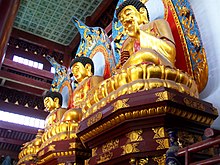"The mind is devoid of mind, For the nature of mind is clear light."
The Three Kayas — the Three Bodies of the Buddha, the Trikaya — describes both the truth in us, as three aspects of the true nature of mind, and to the truth in everything.
According to the Rigpa school, "Everything we perceive around us is nirmanakaya, its nature, light or energy is sambhogakaya; and its inherent truth, the dharmakaya."
"Imagine a sky, empty, spacious, and pure from the beginning; its essence is like this. Imagine a sun, luminous, clear, unobstructed, and spontaneously present; its nature is like this. Imagine that sun shining out impartially on us and all things, penetrating all directions; its energy, which is the manifestation of compassion, is like this: Nothing can obstruct it and it pervades everywhere." — Sogyal Rinpoche
Regarding the nature of the mind, Nirmanakaya represents the energy manifested in compassion, unobstructed and present in everything; sambhogakaya, the nature of the unobstructed clear light of luminosity that is spontaneously present; and dharmakaya, the essence of the truth that is empty, spacious, and pure from the beginning.
Having taken refuge in the Three Jewels, the disciple actually takes refuge in the qualities of realization, as embodied in the Three Bodies of the precious Buddha who is the identity that embodies all three kayas.
Foremost, the Dharmakaya, which arises from accumulation of wisdom — the Truth Body of Tathagata, who is the embodiment of Truth.
It represents the Absolute nature of all things, and embodies the very principle of enlightenment and knows no limits or boundaries, being the unconditioned truth that is empty of conditions, the emptiness in which the mind and all phenomena are originally empty of any identity as the Unborn, into which illusion and ignorance, and any kind of concept, have never entered,
Thus it is empty of a conceptualizable essence of mind which has potential.
That potential takes the form of luminosity recognized as the Sambhogakaya, which arises from accumulation of merit — the Enjoyment Body, the body of mutual enjoyment, the embodiment of form that only appears to bodhisattvas as the aspect of the Buddha, or the Dharma, that the disciple meets in visions and in deep meditation as a body of bliss or clear light manifestation.
Being beyond dualistic limitation and beyond space and time, it pervades everything.
This is the basis for the arising of the Nirmanakaya, which also arises from accumulation of merit — the created body which manifests in time and space, the dimension of ceaseless manifestation, the physical body of the Buddha, appearing as the tamer of various beings, both pure and impure, and is the manifestation of enlightenment, in an infinite variety of forms and ways, in the physical world.
Originally posted: February 23, 2013 7:35 PM
References:
- Prajna
- Prajna or transcendent wisdom: http://www.rigpawiki.org/index.php?title=Prajna
- Prajna: http://en.wikipedia.org/wiki/Prajna
- Quote on clear light: http://www.rigpawiki.org/index.php?title=Quotations:_Prajnaparamita_in_Eight_Thousand_Verses
- Prajnaparamita: http://www.rigpawiki.org/index.php?title=Prajnaparamita
- Prajnaparamita: http://en.wikipedia.org/wiki/Prajnaparamita
- Heart Sutra: http://en.wikipedia.org/wiki/Heart_Sutra * The Heart Sutra is known as Prajnaparamita Hrdaya.
- Refuge in the Three Jewels: http://www.darahasa.ca/buddhism-doctrines/refuge-in-the-three-jewels.shtml
- Three Jewels: http://www.rigpawiki.org/index.php?title=Three_Jewels
- Clear light: http://www.rigpawiki.org/index.php?title=Clear_light
- Trikaya: http://en.wikipedia.org/wiki/Trikaya
- Three kayas: http://www.rigpawiki.org/index.php?title=Three_kayas

No comments:
Post a Comment